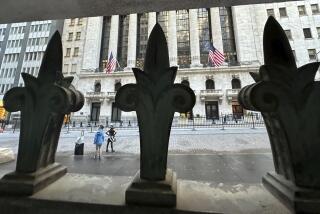Treasury Bonds Trade Between Two Forces
- Share via
The Treasury bond market is torn between two realities: The Federal Reserve may be getting closer to tightening credit, yet foreign central banks continue to be aggressive buyers of American IOUs.
Jitters over the Fed appeared to win out Tuesday, as Treasury yields rose despite strong demand at the Treasury’s auction of new three-year notes.
Many bond investors are nervous in anticipation of Fed Chairman Alan Greenspan’s testimony this week on economic and monetary policy. Greenspan will speak before a House committee today and a Senate committee on Thursday.
If the Fed chief hints that the economy is stronger than data would suggest, and that the central bank can’t show unlimited patience in holding short-term rates at 40-year lows, more bond investors could take that as a sign that tighter credit is on the horizon. That could drive up long-term interest rates, at least temporarily, if investors balk at locking in current yields.
“We can see a significant [bond] sell-off if he in any way plays down” last week’s government report on January employment, said Scott Gewirtz, co-head of Treasury trading at Deutsche Bank in New York. That report showed the economy created a net 112,000 jobs in the month, below expectations.
Some experts say Greenspan probably will stress that the Fed is in no hurry to raise rates. “He will acknowledge the strength in the economy, while mentioning that there are still issues with job creation,” said Peter Cordrey, a bond manager at Prudential Investments in Newark, N.J.
One group of investors doesn’t seem too concerned that current bond yields might look less attractive later in the year.
The Treasury sold $24 billion of three-year notes Tuesday at a yield of 2.33%. So-called indirect bidders, a group that includes foreign central banks, bought 47% of the notes, up from 37% at the previous three-year auction in November.
The bid-to-cover ratio was 2.27, meaning there were $2.27 in bids for each $1 of debt sold -- the highest of any three-year note sale since the government reintroduced the security in May after a five-year hiatus.
The sale buoyed some bond traders’ hopes as the Treasury’s borrowing binge continues with an auction of $16 billion of five-year notes today and $16 billion of 10-year notes Thursday.
The debt is part of an estimated net $177 billion the government will borrow this quarter to cover its budget deficit.
“The Treasury market is being propped up by Asian central banks,” said Andy Brenner, head of fixed-income sales and trading at Investec Ernst & Co. in New York.
Japan’s central bank and others are buying Treasuries in an attempt to keep their currencies from rising too quickly against the weak U.S. dollar. The dollar’s slide means foreign products are more expensive for American buyers. By selling their own currencies to buy dollars, then investing the proceeds in Treasuries, the banks are trying to slow the dollar’s descent.
Japan owned $525.5 billion of U.S. government securities as of November, up from $364.7 billion at the end of 2002, according to Treasury data.
“Japan is likely to continue to intervene to buy dollars,” said Lena Komileva, an economist at bond brokerage Prebon Yamane in London. “Reinvesting those dollars into Treasuries is about the only choice they’ve got.”
But the upbeat news on foreigners’ bond purchases at the three-year T-note auction Tuesday couldn’t keep Treasury yields overall from rising. The 10-year T-note was 4.11%, up from 4.05% Monday. The five-year T-note rose to 3.12% from 3.05%.
Still, bond yields have been struck in relatively narrow ranges in recent weeks. Some traders say that, for now, foreign demand is more than offsetting dwindling interest by domestic investors. But “if [foreign buyers] step away, you will have significantly higher interest rates,” said Investec’s Brenner.
More to Read
Inside the business of entertainment
The Wide Shot brings you news, analysis and insights on everything from streaming wars to production — and what it all means for the future.
You may occasionally receive promotional content from the Los Angeles Times.










